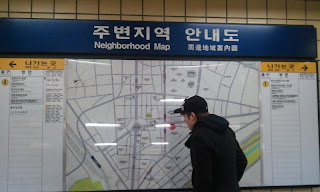Step 1: Decide on a place you'd like to visit.
This often requires consulting Trip Advsor-like websites and traveller blogs. (Korean-based websites are obviously helpful when it comes to images and subway exit info, but they can only get you so far when you aren't fluent in Hangul).
Step 2: Record or recite any information about subway exits, bus stops or landmarks.
I often end up taking a picture (of the website map) with my phone so that I can access it at any point on the journey. It also helps to practice the details with a traveling buddy so you can remember any key things to look for along the way.
* I feel like this is a good time to explain that Korean roadways are too plentiful to be named like Canadian streets do. There are no street signs indicating a Broadway St or Feller Avenue, this is why it is imperative to have a map to follow that includes places to look for.
Step 3: Walk to the nearest subway exit.
I'm fortunate to have exit 5 of the Gwacheon Government Complex stop a few minutes from my door. I live along Line 4 (aka the blue line) which offers a direct route through Seoul heading in the Danggogae direction; it also leads to some key shopping places (E-mart, Home Plus) and restaurants (Outback Steakhouse and Korean BBQ places) in the Oido direction.
**what direction you are traveling is key to making sure you get to where you want to go, so you must always know what the last stop is on that line in the direction you wish to go.
 |
| If you look at near the bottom of this picture you will see the Line 4, the "sky blue" line. I live 18 stops in from Oido, at Government Complex Gwacheon |
Step 4: Stop by the subway machine to ensure your t-money card has funds.
T-money is a card you load with any denomination of money and you can use it for subway and cabs alike. When you swipe your card upon entering the subway system, it automatically deducts 1,050 won (current equivalent to CAD $0.90). Then, depending on how far your travel and/or what transfers you make, money is deducted from your card (at increments of 200 or 300 won) when you swipe out of the subway system. Mhmm, less than $2 for more than an hour of travel. After a round trip, your grand total will be a whopping $2 to $3.
Step 5: Identify the proper exit.
At this point, it is incredibly important to know which exit you would like to surface to ensure you are on the side of the street, train station, or particularly large building. As I mentioned earlier, there are no street signs, so if you’re only instruction is to walk straight out of the exit, turn left at the light and look for the building with the blue lights, starting off on the wrong exit can make for a very interesting search. When you walk up from the subway, you swipe your card and then follow the multiple signs that point you in the direction of your exit. It’s usually 4 or 5 exits to your immediate left and 4 or 5 to your immediate right, and then they branch out from there.
 |
| Zoomed in to the Neighbourhood Map, we were THERE. |
Step 6: Emerge from the Subway system.
Often times there are “Neighbourhood Maps” located at the exit to show you what buildings or “business centers” are nearby; I like to cross-reference these images with the instructions I have brought with me, just to make sure the stars will align when it comes time to arrive at the destination.
 |
| The Neighbourhood Map at Yeongdeungpo Market |
Since you are often looking for landmarks, it’s a good idea to glance upwards at the buildings and the subway signs to indicate if you’re heading in the right direction. Korea can only afford to build up, so you can’t afford to look at eye level when most restaurants and cafes are located on the 2nd (2F), 3rd (3F) or 4th (4F) floors of buildings. Also, you learn how to navigate by “turning at the gold building with the neon pink Hangul sign”, or “passing the blue microphone (sign of a Norebong)” and “stopping just before the Cafe Bene with the wooden panels”. Being observant is key to locating places here.
 |
| Always a good idea to look around at intersections to make sure you didn't miss anything. If you do happen to miss anything, quite frankly, you're SOL and entering adventurous territory :D |
Step 8: Celebrate arriving at your intended destination.
Traveling a couple stops along your subway line, or making a transfer to a popular area in Seoul is far from arduous, but forging an unfamiliar path to a new place can pose some confusion, misdirection and a lot of laughs along the way. I went from being all-too-comfortable getting in my beloved ‘97 Saturn and cruising the 400-series highway to becoming an unknowing passenger of the Seoul Subway System, and I have to say it feels pretty darn rewarding when you arrive at the place you originally set out to find. Even better when you get lost in the process and are then forced to use any technological, conversational or observational skills you have to get back on track. After all, it’s about the lessons we learn from the journey, right?
 |
 ***This particular day, we set off to find Times Square and we did!
***This particular day, we set off to find Times Square and we did!
For more information on Times Square, check out: http://www.visitkorea.or.kr/enu/SI/SI_EN_3_1_1_1.jsp?cid=834090

No comments:
Post a Comment